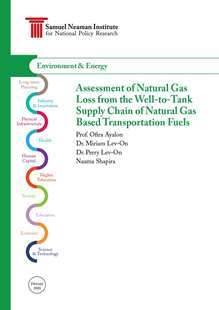Methane (CH4) is the primary component of natural gas and the second largest contributor to greenhouse gas (GHG) emissions, following carbon dioxide (CO2), and is thus the focus of global efforts to reduce the warming of the atmosphere. The global warming potential of methane is over 25 times that of CO2. Methane also contributes to the formation of photochemical smog, including the formation of tropospheric ozone, attracting the attention of regulators, the media, industry and environmental organizations.
Natural gas is an important component of Israel’s economy, having also a positive environmental impact. Natural gas produced from domestic sources promotes energy independence and contributes to reduced greenhouse gas emissions since the amount of CO2 emitted per unit of energy is low when compared to other fossil fuels.
This study focuses on estimating natural gas losses and GHG emissions (CO2 and CH4 only) in the Well-to-Tank (WTT) supply chain for producing natural gas-based transportation fuels, including compressed natural gas (CNG), methanol for gasoline blending and gas to liquid (GTL) products. Also, in accordance with a new 2030 strategic plan proposed by the Energy Ministry, this study also provides estimates of emissions resulting from generating electricity by natural gas that is used for charging electric vehicles.
Specific objectives of the study: reviewing the literature and the latest data regarding natural gas loss rates through its supply chain; assessing GHG emissions resulting from venting, blow down and leakage; comparing emissions data from selected countries for gas-based fuels production; and recommending policy measures to reduce and control GHG emissions from natural gas operations. It should be noted that the scientific review and analysis found in this study are limited due to lack of sufficient data. Data is available only from a few selected countries, primarily in the U.S. There is only limited publicly available data from the natural gas sector in Israel. In addition, because some of the data is confidential business information and due to budgetary constraints, it was not possible to perform extensive data collection to more accurately characterize the sector in Israel.
Main findings: according to estimates of the International Energy Agency, the average global methane loss is around 1.7% of the produced gas which is lost and released to the atmosphere prior to reaching the consumer. The range of estimated emissions across the supply chain is large – around 4 to 42 grCO2e/MJ. Methane emission intensities vary between 0.2% -10% of the methane contained in the natural gas. Actual losses and emissions intensities are unique for each country. They should be calculated in conjunction with national emission inventories and should be based on local production and marketing data. Global recommendations include: development of updated emission factors for high priority emission sources; collection of new measurement data collection and targeted adjustment of emission factors representing the sector activities; implementation of proper sampling and accurate measurements to ensure representativeness; and estimation of emissions variability and uncertainty based on local emission factors rather than generic ones.
Analyzing the WTT data for CNG in the EU it is found that on an energy basis, the emission intensities are 9.9, 3.74 and 0.11 for CO2, CH4 and N2O, respectively, in units of grCO2e/MJ. When using the GREET model the CNG emission intensity is 18.4 grCO2e/MJ. The emission intensity to produce methanol from natural gas varies between different facilities, natural gas sources and the technology used. Emission intensity in the cases examined range from 0.3 to 0.9 tCO2e/tMeOH. The WTT emission intensities for GTL was found to be in the range of 28-90 grCO2e/MJ for the conversion of natural gas to gasoline, and in the range of 25-191 grCO2e/MJ for the conversion to diesel. For GTL, the evaluation boundaries should include emissions from transportation of the product – transfer to the conversion facility, to the fueling station, and vehicles’ fueling.
Estimating Upstream operations emissions in Israel is limited to information reported to the Israeli PRTR system by natural gas facilities for the years 2014-2017. Calculating methane emissions using IPCC Tier 1 factors (based on the volume of natural gas produced), yields values that are higher by 30-50% as compared to data reported directly to the PRTR.
In light of the fact that there are no reliable data to derive recommendations or to perform cost-benefit analyses, the main recommendation of the study is to require the industry to perform leak surveys and to report the methods used while adhering to transparent processes and on-going control, both by the industry and by the Government.












